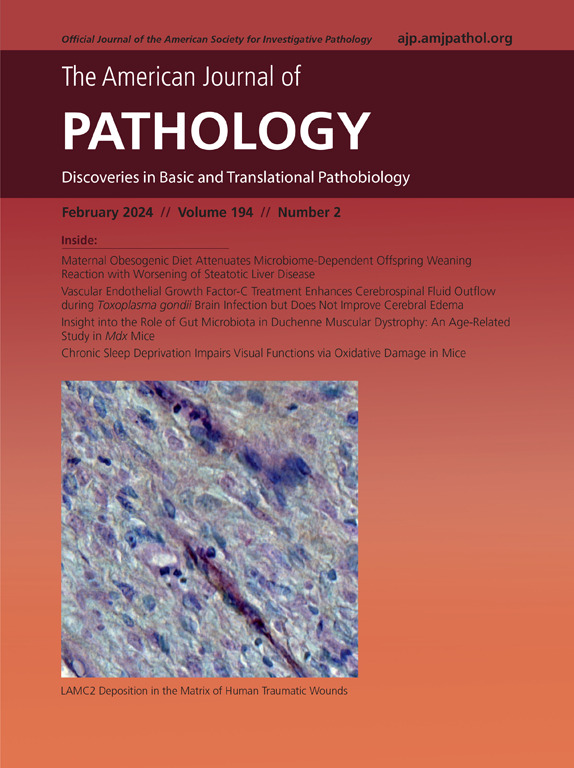睾酮诱导的 H3K27 去乙酰化参与了颗粒细胞增殖抑制和多囊卵巢综合征的发病机制。
IF 4.7
2区 医学
Q1 PATHOLOGY
引用次数: 0
摘要
多囊卵巢综合征(PCOS)是育龄妇女不孕的主要原因。高雄激素、多囊卵巢和慢性无排卵是其典型的临床特征。然而,高雄激素与卵泡生长畸变之间的相关性仍未被揭示。为了加深我们对雄激素过多导致卵巢颗粒细胞(GCs)分子改变的了解,我们评估了人颗粒-黄体细胞(hGCs)和永生化人GCs(KGN)的表观遗传学变化和受影响的基因表达。此外,还建立了由双氢睾酮(DHT)诱导的多囊卵巢综合症小鼠模型。研究发现,过量睾酮会明显降低组蛋白 H3 上赖氨酸 27 的乙酰化(H3K27ac)。H3K27ac 染色质免疫沉淀测序(ChIP-seq)数据显示,细胞周期相关基因(CCND1/CCND3/PCNA)的表达下调,实时定量 PCR 和 Western 印迹证实了这一点。Ki-67免疫荧光和流式细胞计数分析也证实了应用睾酮会阻碍细胞增殖。此外,睾酮还影响了 CK2α 的核转位,从而增加了组蛋白去乙酰化酶 2(HDAC2)的磷酸化水平。抑制 CK2α 核转位或沉默 HDAC2 的表达可有效延缓 H3K27 乙酰化。同时,多囊卵巢综合症小鼠模型实验也表明,GCs 中的 H3K27ac 减少,HDAC2 磷酸化增强。PCOS 小鼠 GC 中的细胞增殖相关基因也出现了下调。总之,人类和小鼠GC中的高雄激素引起了H3K27Ac畸变,而H3K27Ac畸变与CK2α核易位和HDAC2磷酸化有关,参与了PCOS患者卵泡发育异常的过程。本文章由计算机程序翻译,如有差异,请以英文原文为准。
Testosterone-Induced H3K27 Deacetylation Participates in Granulosa Cell Proliferation Suppression and Pathogenesis of Polycystic Ovary Syndrome
Polycystic ovary syndrome (PCOS) is the leading cause of infertility in reproductive-age women. Hyperandrogenism, polycystic ovaries, and chronic anovulation are its typical clinical features. However, the correlation between hyperandrogenism and ovarian follicle growth aberrations remains poorly understood. To advance our understanding of the molecular alterations in ovarian granulosa cells (GCs) with excessive androgen, epigenetic changes and affected gene expression in human granulosa-lutein cells and immortalized human GCs were evaluated. A PCOS mouse model induced by dihydrotestosterone was also established. This study found that excessive testosterone significantly decreased the acetylation of lysine 27 on histone H3 (H3K27Ac). H3K27Ac chromatin immunoprecipitation–sequencing data showed down-regulated expression of cell cycle–related genes CCND1, CCND3, and PCNA, which was confirmed by real-time quantitative PCR and Western blot analysis. Testosterone application impeding cell proliferation was also shown by Ki-67 immunofluorescence and flow-cytometric analysis. Moreover, testosterone influenced casein kinase 2 alpha (CK2α) nuclear translocation, which increased the phosphorylation level of histone deacetylase 2 (HDAC2). Inhibition of CK2α nuclear translocation or silenced HDAC2 expression efficiently retarded H3K27 acetylation. PCOS mouse model experiments also demonstrated decreased H3K27Ac and enhanced HDAC2 phosphorylation in GCs. Cell proliferation–related genes were also down-regulated in PCOS mouse GCs. In conclusion, hyperandrogenism in human and mouse GCs caused H3K27Ac aberrations, which are associated with CK2α nuclear translocation and HDAC2 phosphorylation, participating in abnormal follicle development in patients with PCOS.
求助全文
通过发布文献求助,成功后即可免费获取论文全文。
去求助
来源期刊
CiteScore
11.40
自引率
0.00%
发文量
178
审稿时长
30 days
期刊介绍:
The American Journal of Pathology, official journal of the American Society for Investigative Pathology, published by Elsevier, Inc., seeks high-quality original research reports, reviews, and commentaries related to the molecular and cellular basis of disease. The editors will consider basic, translational, and clinical investigations that directly address mechanisms of pathogenesis or provide a foundation for future mechanistic inquiries. Examples of such foundational investigations include data mining, identification of biomarkers, molecular pathology, and discovery research. Foundational studies that incorporate deep learning and artificial intelligence are also welcome. High priority is given to studies of human disease and relevant experimental models using molecular, cellular, and organismal approaches.

 求助内容:
求助内容: 应助结果提醒方式:
应助结果提醒方式:


